Prices have been brought up to date, and are for stamps in 'average' condition. The currency is now selectable, the default is British Currency (£). I have revised Hiscocks' original listing, though leaving references to the original designations. The new designations have 'RH' numbers (Revised Hiscocks) to avoid confusion. Setup |
| Shortcuts to different sections | |||||||||
| 6d details | 6d varieties | 1s details | 1s varieties | Printers imprint | Watermark | Colours | Sheet | Stationery | Maps |
Steve Hiscocks wrote:
The aim of this company was to set up private telegraph lines and rent them to their customers — presumably in the largest cities. It also owned the
"West Highland Telegraph" line from Glasgow to Helensburgh some 35 miles to the WNW and it was for paying the charges on messages over this
line that stamps were issued in 1864. There is some mystery over these stamps, firstly in that no used copies have ever been reported, although
there is equally no evidence for their not being used, and secondly in that records refer to four values — 3d, 6d, 9d and 1s — while only two, the 6d
and 1s, have been reported. The two known values are in fact fairly common and are found with controls in a variety of colours. Authorities differ on
the significance of these control colours but I have taken the view that all were issued rather than their being mostly colour trials because all colours
seem too common to be trials. The stamps were reportedly engraved and printed by Waterlow and Sons and it has been suggested, in view of the
rather poor quality of printing, that this was done in Glasgow rather than London. The company was purchased by the Postmaster-General in 1869 or 1870.
My Notes:
Registered on 20th. September 1860.
The original die was engraved by Waterlow and Sons and a transfer block of 5 made from it to produce sheets of 100.
The production, pattern of flaws and watermark are just like that of the Bonelli's Telegraph.
The business operated successfully in London, Newcastle, Leeds, Liverpool, Manchester, Glasgow and via the
West Highland Telegraph which they owned, the resort town of Helensburgh on the Clyde, 33 miles from Glasgow.
According to Steven Roberts writing about the West Highland Telegraph :
"Its lines ran from the centre of Glasgow along the north bank of the Clyde river to Helensburgh, Row, Roseneath, Blairmore, Cot House and East Craighead to West Craighead;
West Craighead north along the road around Loch Awe to Inverary and Oban; West Craighead south down the Cantyre peninsula to Ardrishaig, Campbeltown and the Cantyre Light on
the tip of the Mull; and from Cot House south past Holy Loch along the west bank of the Clyde to Dunoon, Toward, Ardrie Point, Ardbeg and Rothesay."
This used 4 submarine cables and involved 10 individual lines. For those like me, with a poor knowledge of the area, a page has been added with MAPS of the West Highland Telegraph.
It should be noted that John Pender, the managing director of the Atlantic Telegraph Company and a director of the British & Irish Magnetic Telegraph Company,
and later, creator of the Eastern Telegraph Company, had a country house on the line and helped financially to support the station at Minaird.
See also Steven Roberts on the Universal Private Telegraph Co.
Everett Ramsey has pointed out a further source of information on the West Highland Telegraph at HistoricKilmun.org, which also shows a map.
According to S. E. R. Hiscocks, records refer to four values, 3d, 6d, 9d and 1s but only the 6d and 1s values are known today.
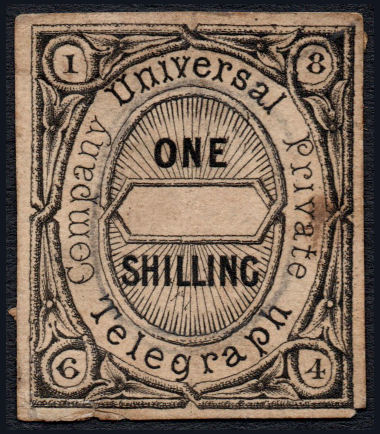 |
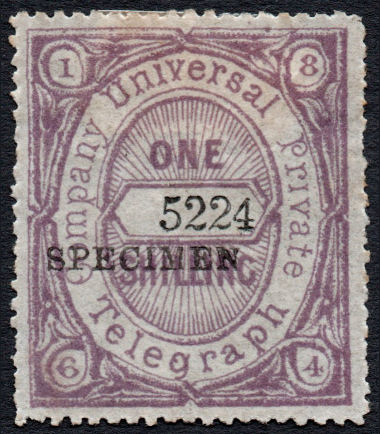 |
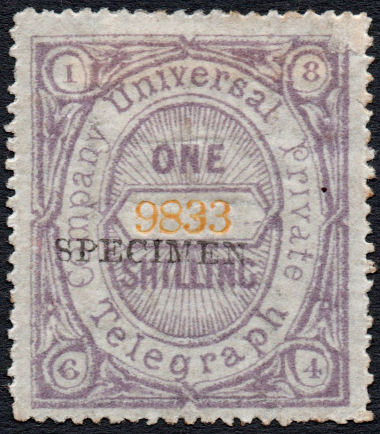 |
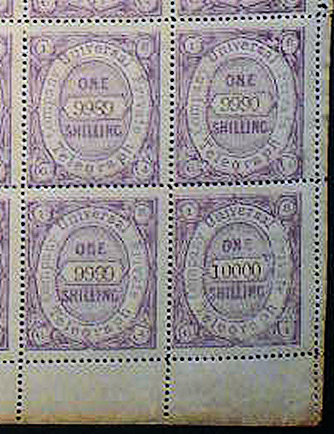 |
| Proof of the One Shilling. | Specimen with black control. | Specimen with yellow control (yellow 9863 is shown below). |
Last control number. |
| Images courtesy of Steve Lawrie. | Anonymous. | ||
In addition these are only known unused, except for a couple I have seen put through the post in 1956.
Perhaps this is an indication that they were more successful at destroying used forms than other companies.
Alternatively, as has been suggested, perhaps they were never used. No forms except a receipt for 2s, are known.
The specimens are interesting, 16¼ x 2 mm seriffed (not matching any SG type). Presumably applied by Waterlow & Sons, but I have not seen any Bonelli specimens.
Are they specimens of the stamp or specimens of the control numbers ? These two have the 'correct' flaws expected for the control numbers.
Interestingly, 9863 with a yellow control and similar shade and centring can be seen below.
It is strange that they only used 4-digit numbers (+10000), you would have thought with a name like 'Universal' they would think bigger.
The company was bought-out by the P.M.G in 1869 or 1870 at which time some of the remaining stocks of stamps came on the market.
Some though remained unknown for decades.
The sheets of stamps consisted of 10 rows of 10 stamps each, bearing the imprint 'Waterlow & Sons, London'.
They were line-perforated 12½.
Minor varieties on each stamp show that there were five different ones printed twice on each row.
These were given control numbers in a variety of colours, starting with 0001 to 0100 for the first sheet, 0101 to 0200 for the next sheet up to 9901 to 10000
It has been suggested that the colours changed because the counter reached the end, but clearly it had 5 digits.
at which point the sequence started again, though perhaps with a different colour control. But did the top 'wheel' really only have a blank and '1' ? Why couldn't it go to 99999 ?
It has been said that the colours were because of the limitations to the highest number. I have my doubts.
Some control colours appear to have been 'Unknown' in Victorian times and 'Discovered' later.
Unusually, they appear to be unknown without control numbers.
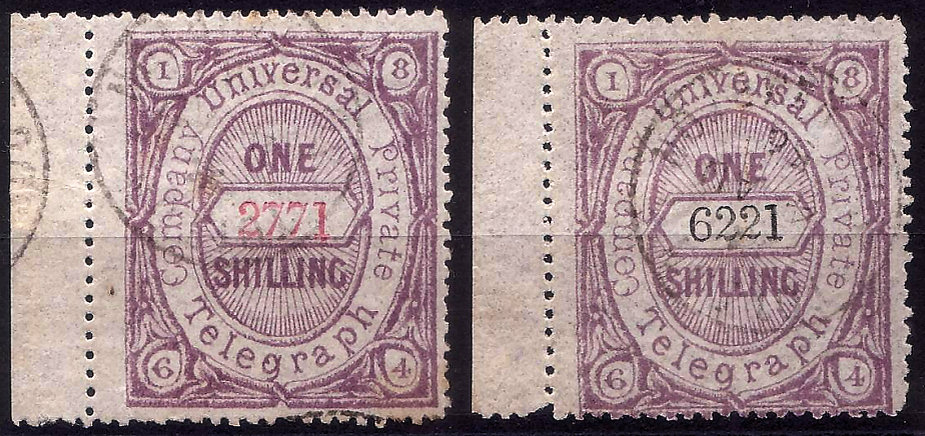
Hard to see, but these are also Totton Postal cancels of 1956, courtesy of Steve Lawrie.
They are unknown telegraphically used, as would be expected.
Perf.12¾ (Hiscocks says 13, L&H say 12½)
I have not seen any examples or illustrations of the 'Telegraph' double variety,
somewhat strange considering the low prices quoted!
Though the colour of the 1/- value is generally described simply as lilac, it is actually quite variable and sometimes nearer purple.
| RH # | Hisc. | Description | Rarity | Mint | Used |
|---|---|---|---|---|---|
| RH6 | H6 | 1s lilac (shades), brown control | Common | 4.20 | - |
| RH7 | H7 | 1s lilac (shades), red control | Common | 3.80 | - |
| RH8 | H8 | 1s lilac (shades), lilac control | Common | 4.80 | - |
| RH9 | H9 | 1s lilac (shades), green control | Common | 4.00 | - |
| RH10 | H10 | 1s lilac (shades), deep yellow control | Common | 3.50 | - |
| RH11 | H11 | 1s lilac (shades), black control | Common | 4.20 | - |
| RH12 | - | 1s lilac (shades), dark blue control | Rare | - | - |
On the 6d value, the word 'Telegraph' is variably aligned within the frame. Compare the letter 'T' between columns 1 and 2 (or 6 and 7) below.
In column 1 (6) the letter 'h' is shortened into an 'n'. The 5 known control colours are also shown here.
S. E. R. Hiscocks lists a variety with 'Telegraph' double, but I have not seen it.
I have recently added the varieties listed by Raymond Lister (1961).
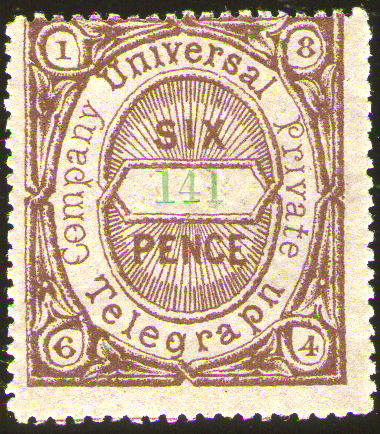 |
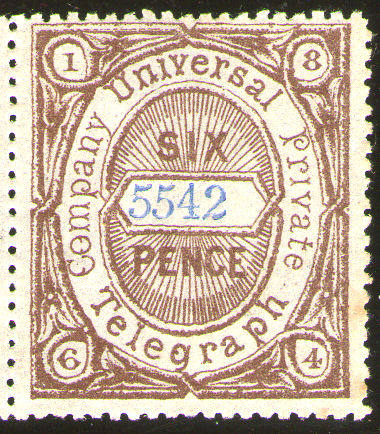 |
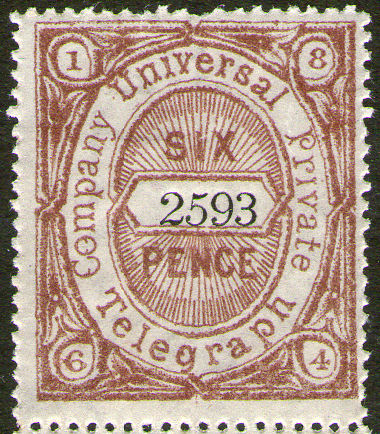 |
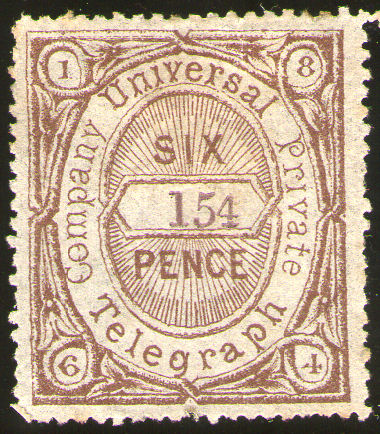 |
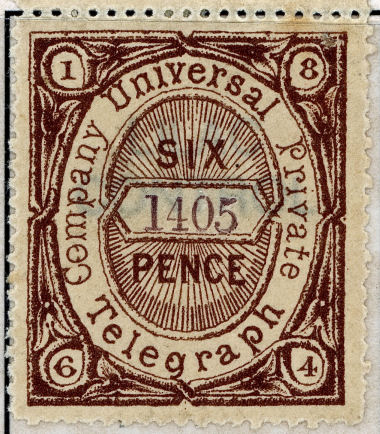 |
| 6d Column 1, yellow-green ('n' for 'h' in 'Telegraph') |
6d Column 2, blue (close 'T' + mark on 'n' |
6d Column 3, black (scratched 'I' in 'SIX' + dot before and thin line under 'U' of 'Universal') |
6d Column 4, lilac ('y' of 'Company' broken + broken serif of '1' in NW corner) * |
6d Column 5, lilac. courtesy of Mark Gibson. Bulge in thick frame above 'ra' of 'Telegraph' |
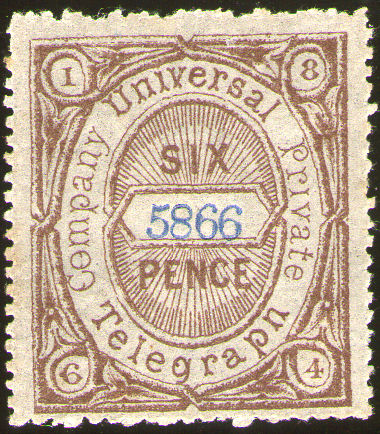 |
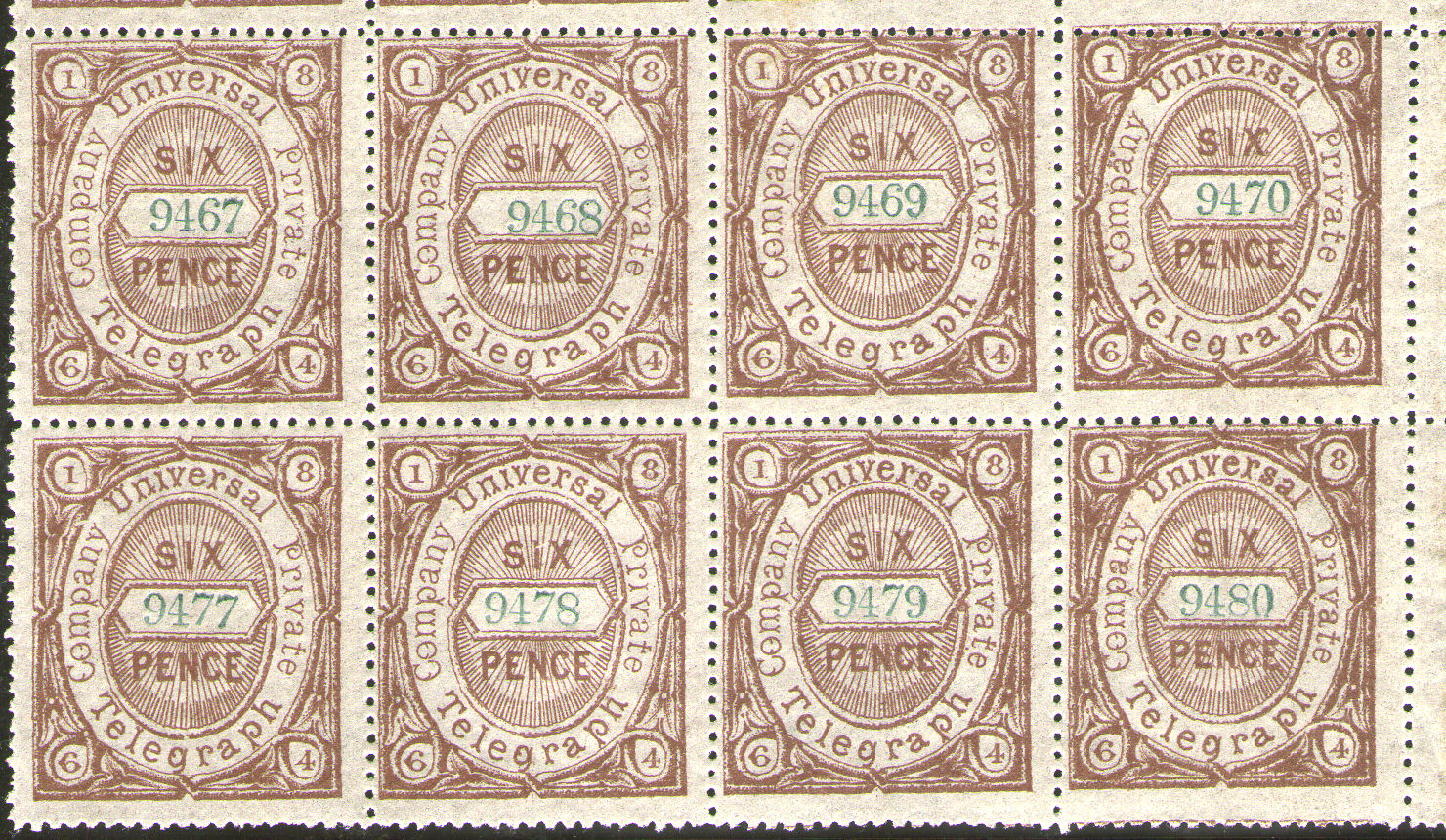 | |||
| 6d Column 6, blue ('n' for 'h' in 'Telegraph') |
6d Column 7, blue-green (close 'T' + mark on 'n' |
6d Column 8, blue-green (scratched 'I' in 'SIX' + dot before and thin line under 'U' of 'Universal') |
6d Column 9, blue-green ('y' of 'Company' broken + broken serif of '1' in NW corner) * |
6d Column 10, blue-green. Bulge in thick frame above 'ra' of 'Telegraph' |
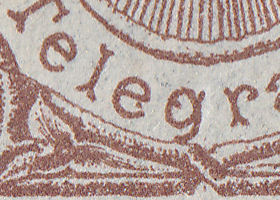
* On column 4/9 stamps there is an additional mark in the second 'e' of 'Telegraph' on 9 stamps (out of 20) per sheet (according to Lister).
It can be seen above on 64, 74 and 94 but not 04, 14 or 54. It is also on 59, 69, 79 and 99 but not 29 or 39.
Using '*' to represent dots and 'o' to represent no dots, gives this table (so far):
Column 4:
| 04 | 14 | 24 | 34 | 44 | 54 | 64 | 74 | 84 | 94 |
|---|---|---|---|---|---|---|---|---|---|
| o | o | o | * | * | * |
Column 9:
| 09 | 19 | 29 | 39 | 49 | 59 | 69 | 79 | 89 | 99 |
|---|---|---|---|---|---|---|---|---|---|
| o | o | * | * | * | * |
I could do with some help completing these.
On the 6d, Lister (1961) says "Additional varieties appear on Nos. 7, 19, 21, 26, 34, 52, 75, 77, 81 and 96 in sheet."
I have noticed an additional constant variety on 54.
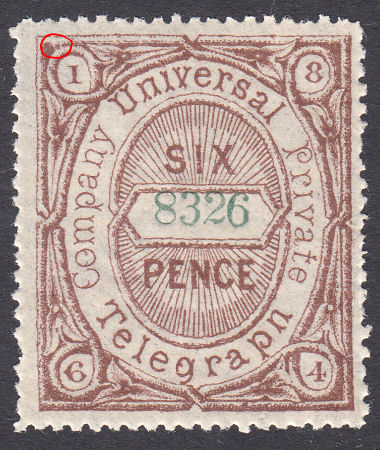 Stamp '26', white marks top-left. |
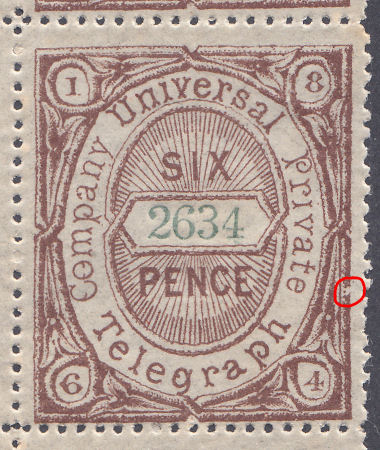 Stamp '34', damaged frame at lower right side. |
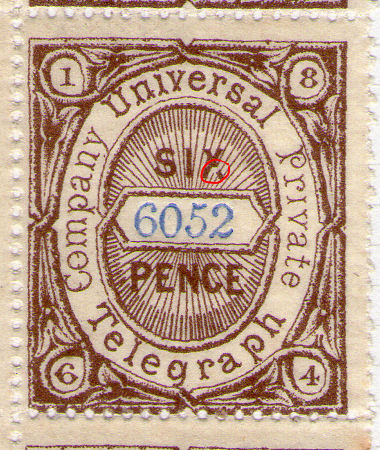 Stamp '52', broken 'X' in 'SIX'. |
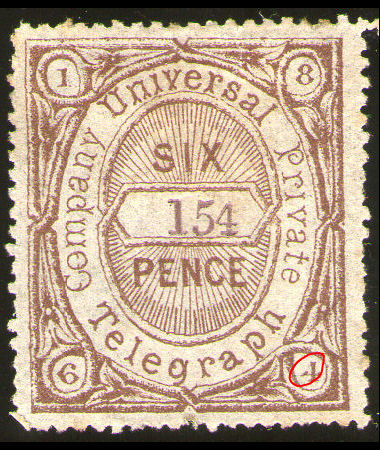 Stamp '54', diagonal of the '4' (of 1864) is broken. |
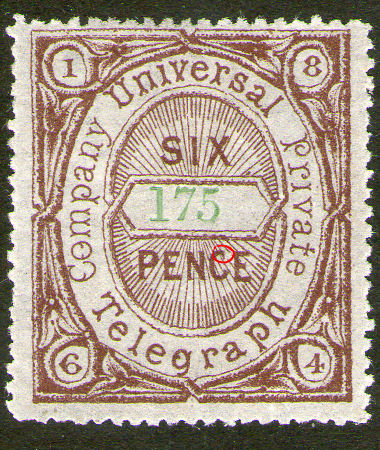 Stamp '75', broken 'C' in 'PENCE'. |
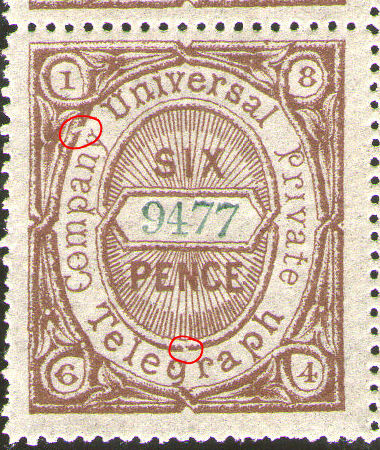 Stamp '77', breaks above the 'g' and 'y'. |
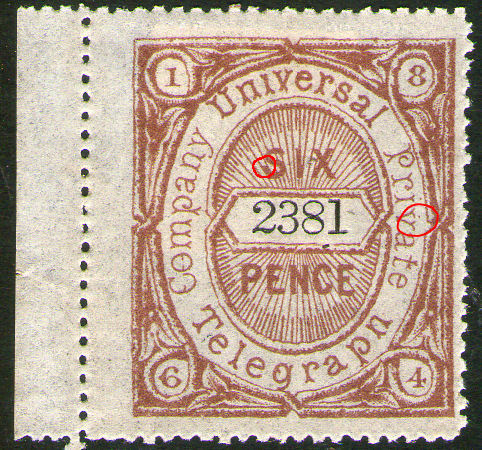 Stamp '81', Longer 'S' of 'SIX' and a dot over the 'v' of 'Private'. |
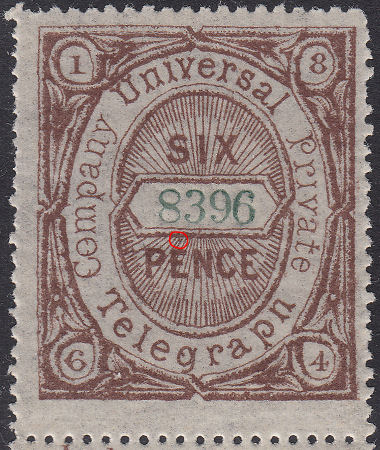 Stamp '96', blob above the 'E' of 'PENCE'. |
It has long been considered that the 1s comes in 6 colours of control, namely Red, Black, Green, Yellow, Brown, Lilac. Here is a new colour, dark blue :
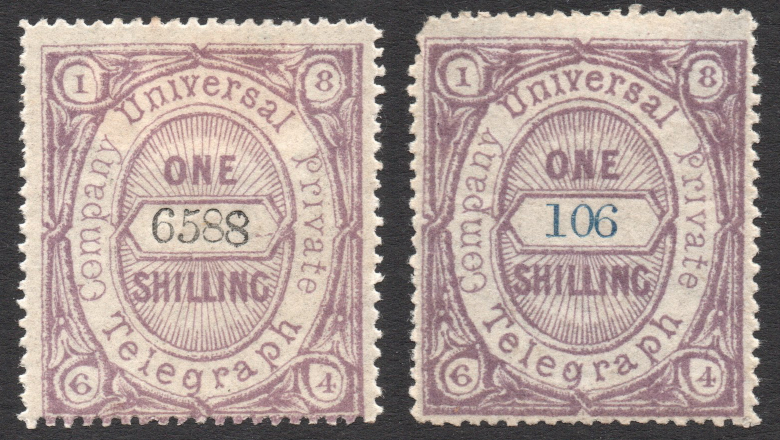
It is scanned together with a black control. 106 is a very dark blue, but it is distinct from the black.
You might want to check the ones you have down as black ! I have only seen this one so far.
Image courtesy of Steve Lawrie.
The second sequence of five is a repeat of the first sequence of five in each row of 10.
Column 2 (7) has a small dot on the lower right and column 3 (8) has a scratch mark in the same place.
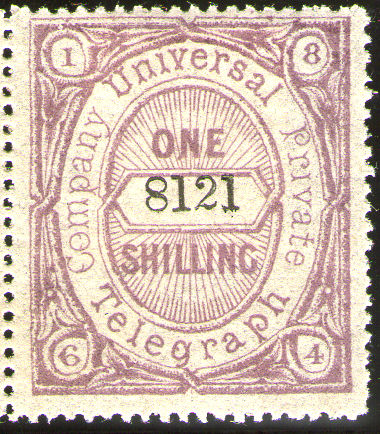 |
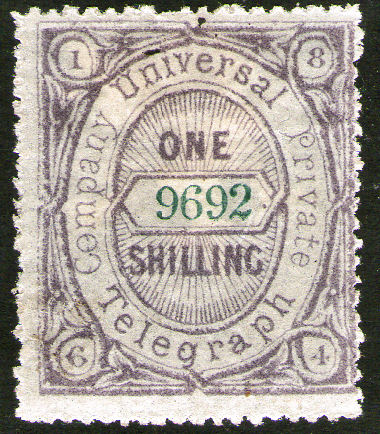 |
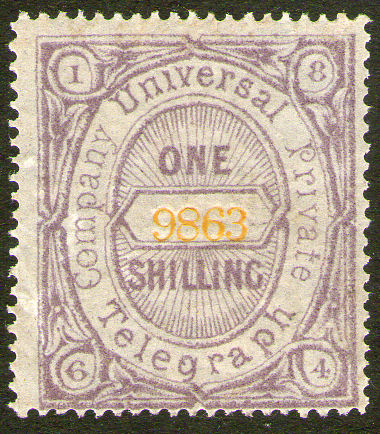 |
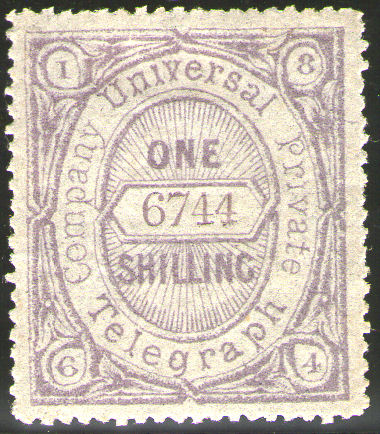 |
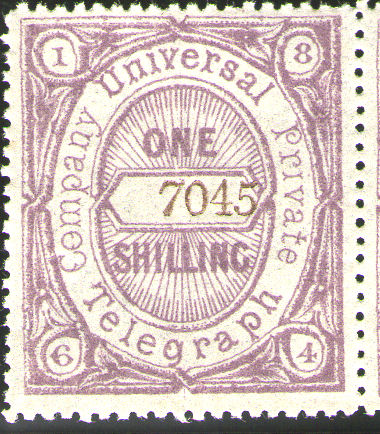 |
| 1s Column 1, black Mark bottom left of 'N' in 'ONE' |
1s Column 2, green. Long left 'tail' to 'P' in 'Private' Additional dot to right of control tablet * |
1s Column 3, yellow (scratch on right) | 1s Column 4, lilac line through frame below 'a' of 'Telegraph' |
1s Column 5, brown (outer frame of control tablet broken below 'N' of 'ONE' |
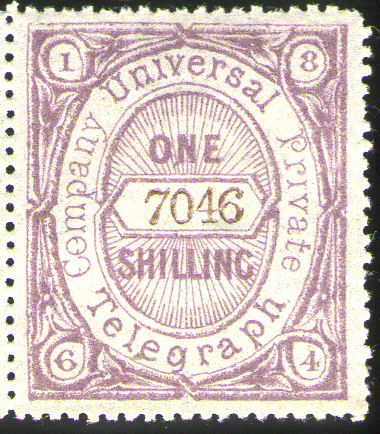 |
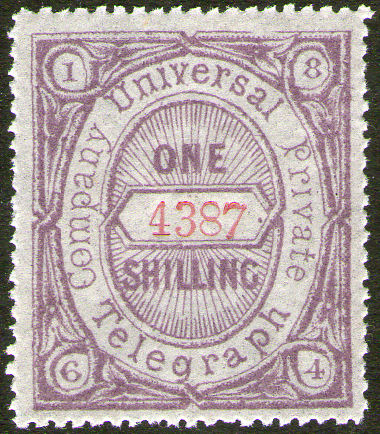 |
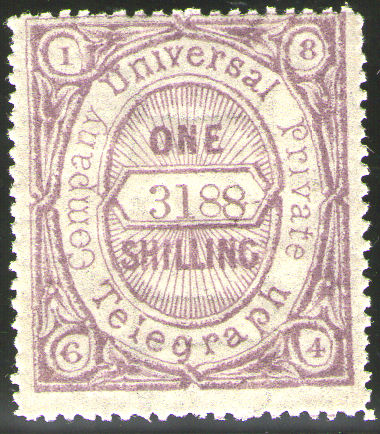 |
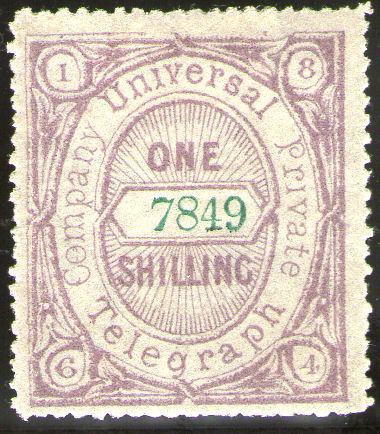 |
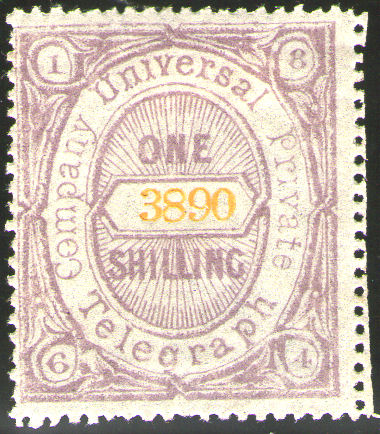 |
| 1s Column 6, brown Mark bottom left of 'N' in 'ONE' | 1s Column 7, red. Long left 'tail' to 'P' in 'Private' Additional dot to right of control tablet * |
1s Column 8, lilac (scratch on right) | 1s Column 9, green line through frame below 'a' of 'Telegraph' | 1s Column 10, yellow (outer frame of control tablet broken below 'N' of 'ONE' |
* On column 2/7 stamps the additional mark to the right of the control number is on 10 stamps (out of 20) per sheet.
It is on all the column 2/7 stamps of the bottom half of the sheet (52, 57, 62, 67, 72, 77, 82, 87, 92 and 97.
There is also a dot near the base of 'v' in Universal'.
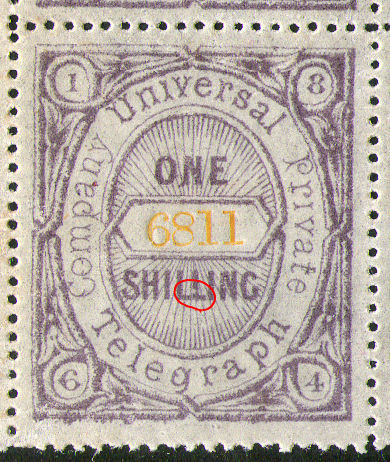 Stamp '11', damage to second 'L' in 'SHILLING'. |
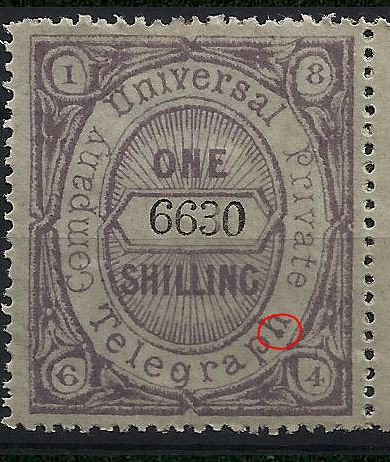 Stamp '30', malformed left leg of 'h'. |
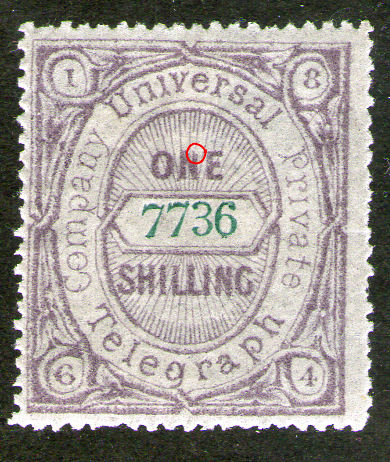 Stamp '36' - Top-right of 'N' in 'ONE' broken. |
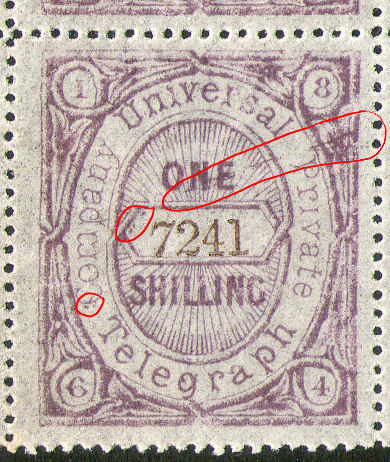 Stamp '41' has a rather spectacular scratch. |
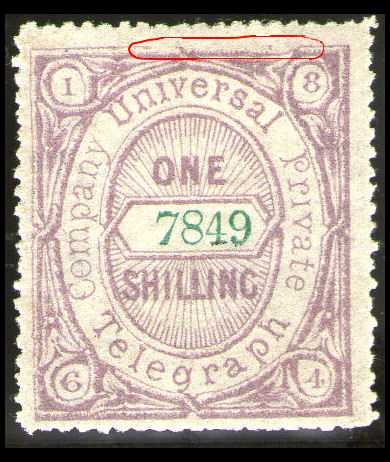 Stamp '49', has a large frame-break at the top. |
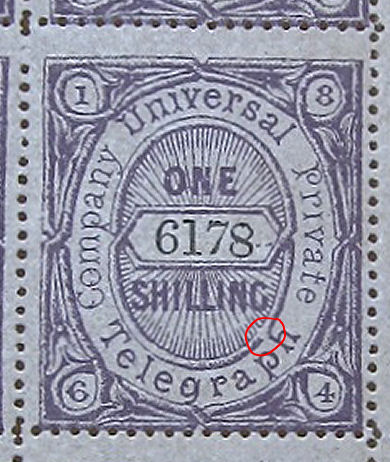 Stamp '78', frame-break above 'h' of 'Telegraph'. |
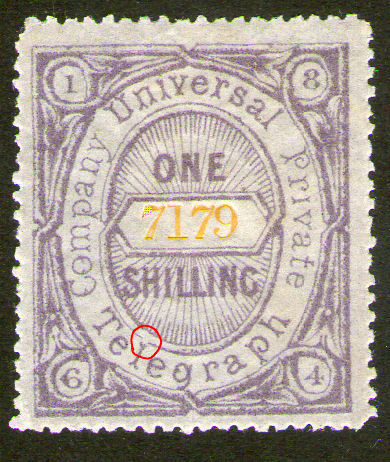 Stamp '79' - frame-break above 'l' of 'Telegraph'. |
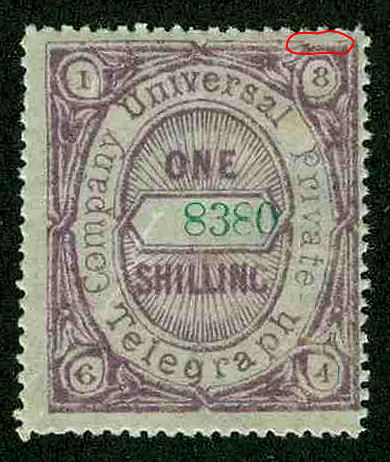 Stamp '80', frame-break above '8'. |
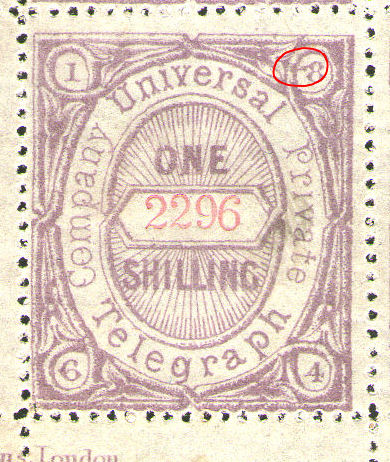 Stamp '96', has a mark in the '8' corner. |
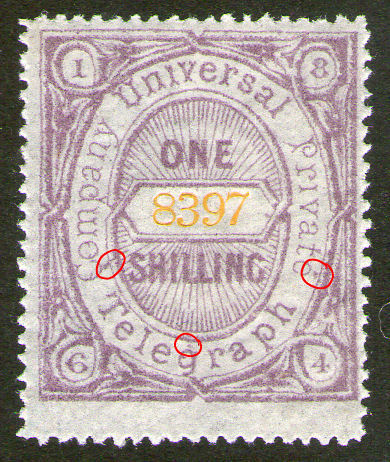 Stamp '97', has marks by 3 of the letters. |
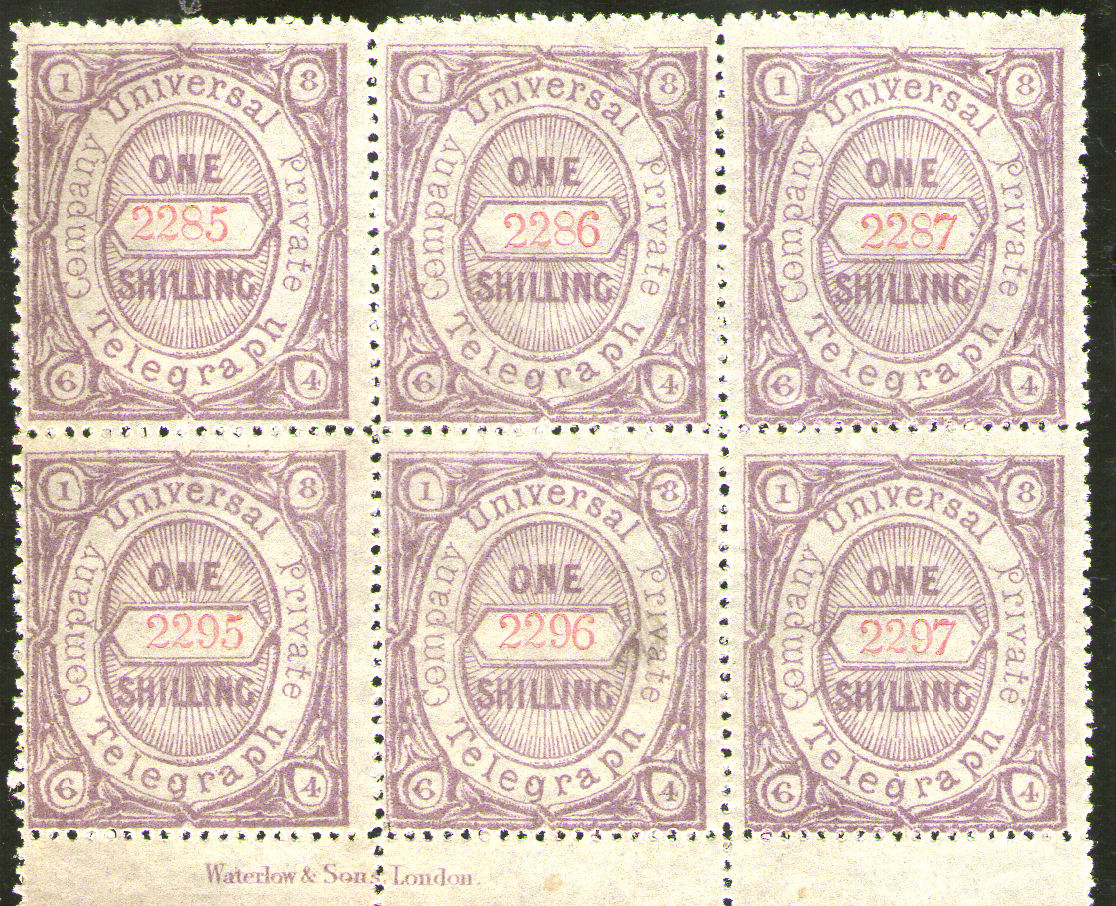 |
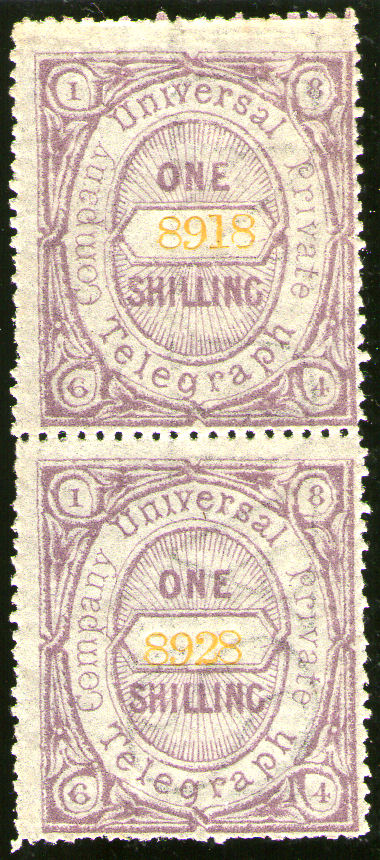 |
| 1s Columns 5, 6 & 7 (red) showing printers imprint and flaw on column 7 (dot on right of control). | 1s Column 8 (yellow) showing scratch on right. |
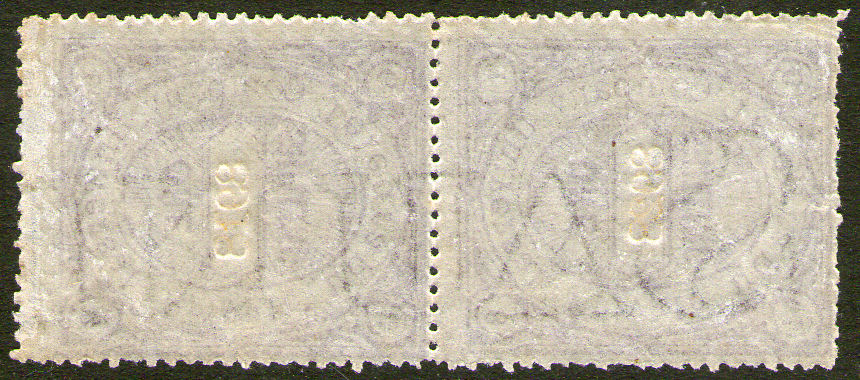 |
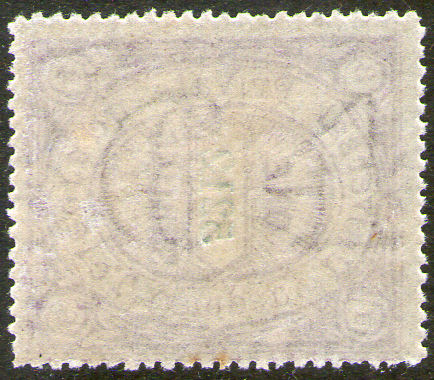 |
|
| <— top 8918 (yellow) | 8928 (yellow) | 5212 (green) top —> |
| Watermark '64'. Note this is reversed as viewed from the front. | ||
A 6d block showing 'T H SAUNDE' and a 1s pair with 'RS'.
| <— bottom 2644 (Blue-green) | 2634 (Blue-green) | 2624 (Blue-green) | 2614 (Blue-green) top —> | 8604 (Blue-green) top —> |
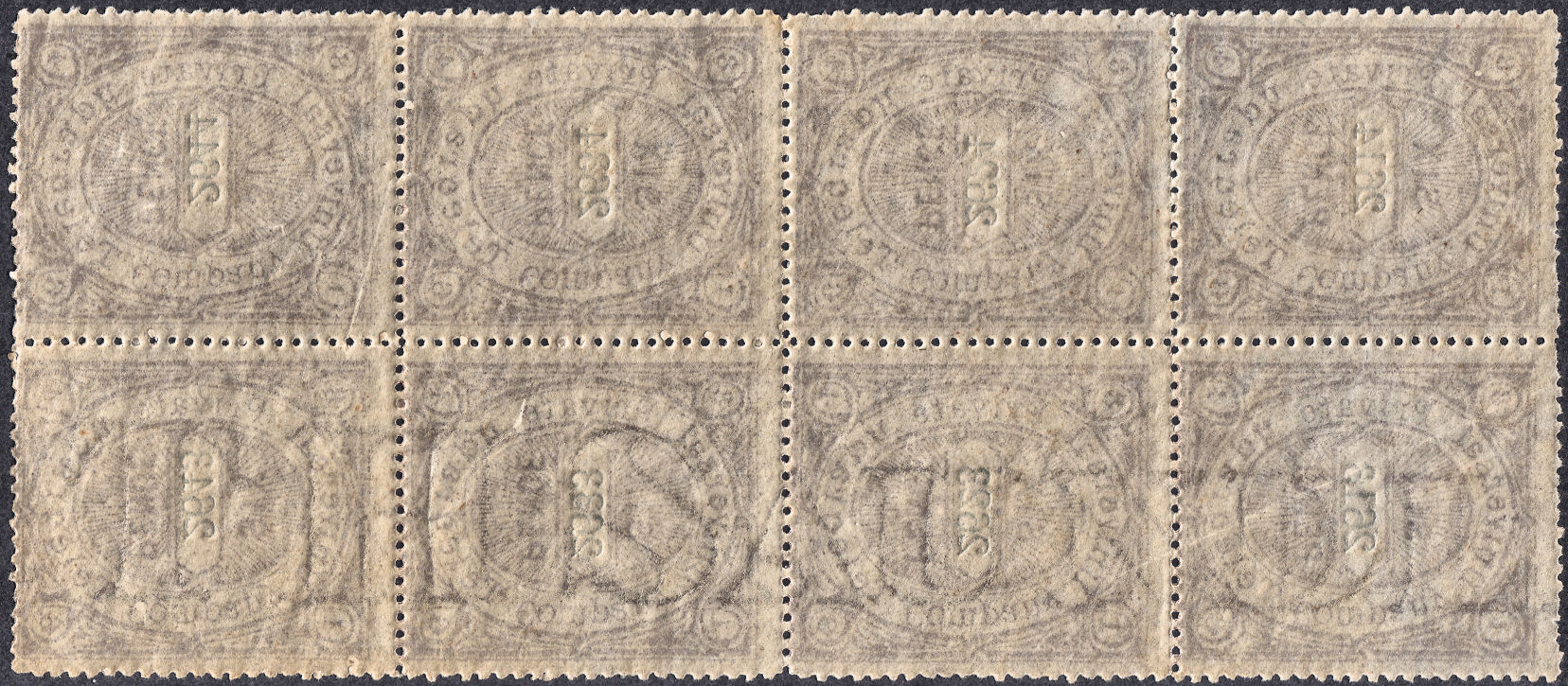 |
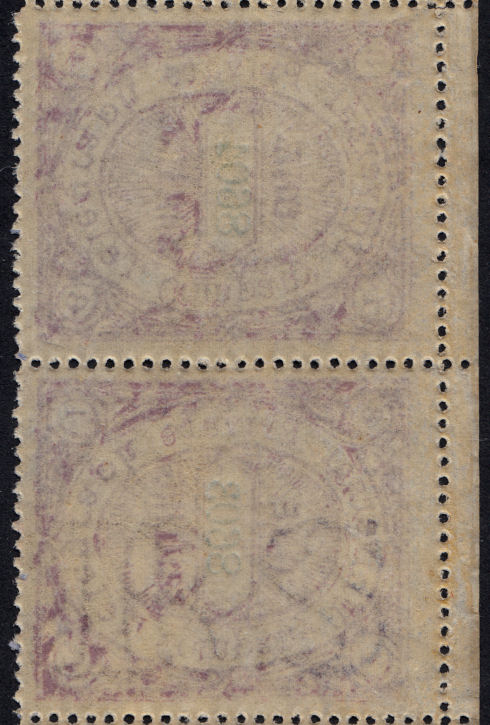 |
|||
| <— bottom 2643 (Blue-green) | 2633 (Blue-green) | 2623 (Blue-green) | 2613 (Blue-green) top —> | 8603 (Blue-green) top —> |
A 1s block showing '1864'.
| <— top 6979 (yellow) | 6989 (yellow) | 6999 (yellow) bottom —> |
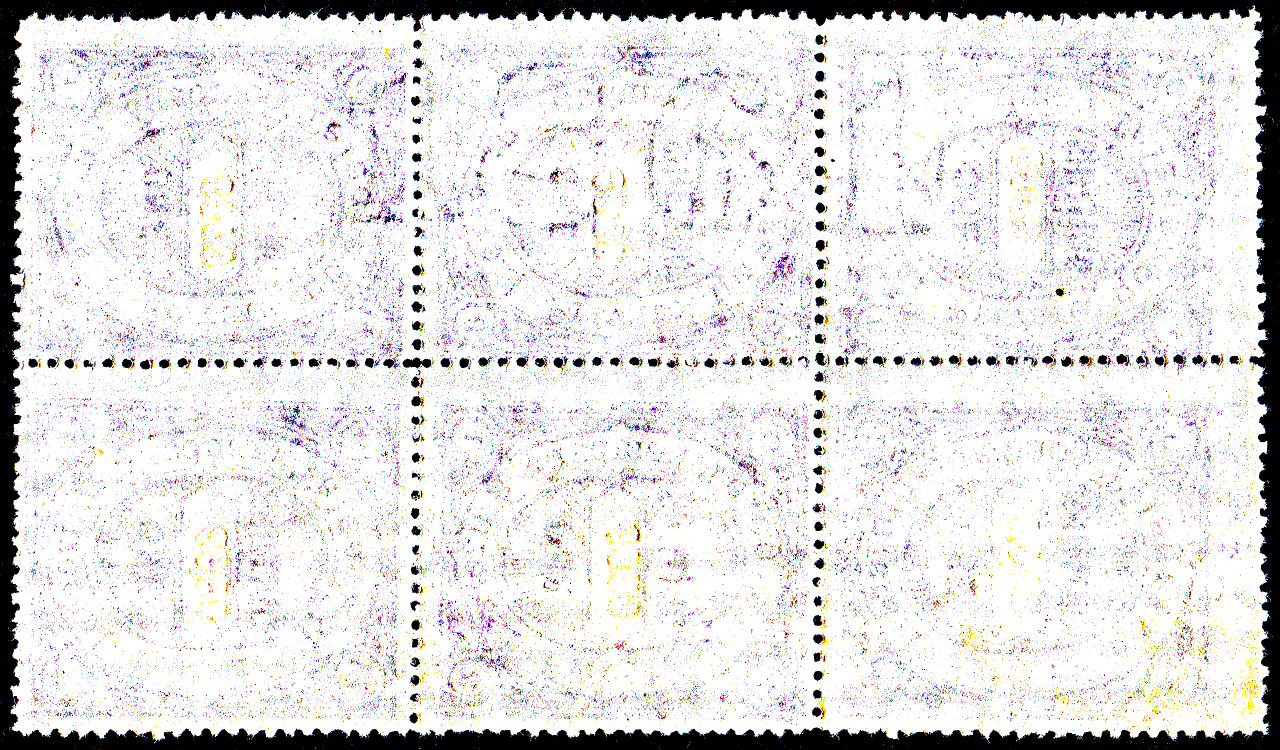 |
||
| <— top 6980 (yellow) | 6990 (yellow) | 7000 (yellow) bottom —> |
Finally a 1/- corner block of 15, showing the complete watermark.
| <— bottom 7160 (Brown) | 7170 (Brown) | 7180 (Brown) | 7190 (Brown) | 7200 (Brown) bottom —> | |
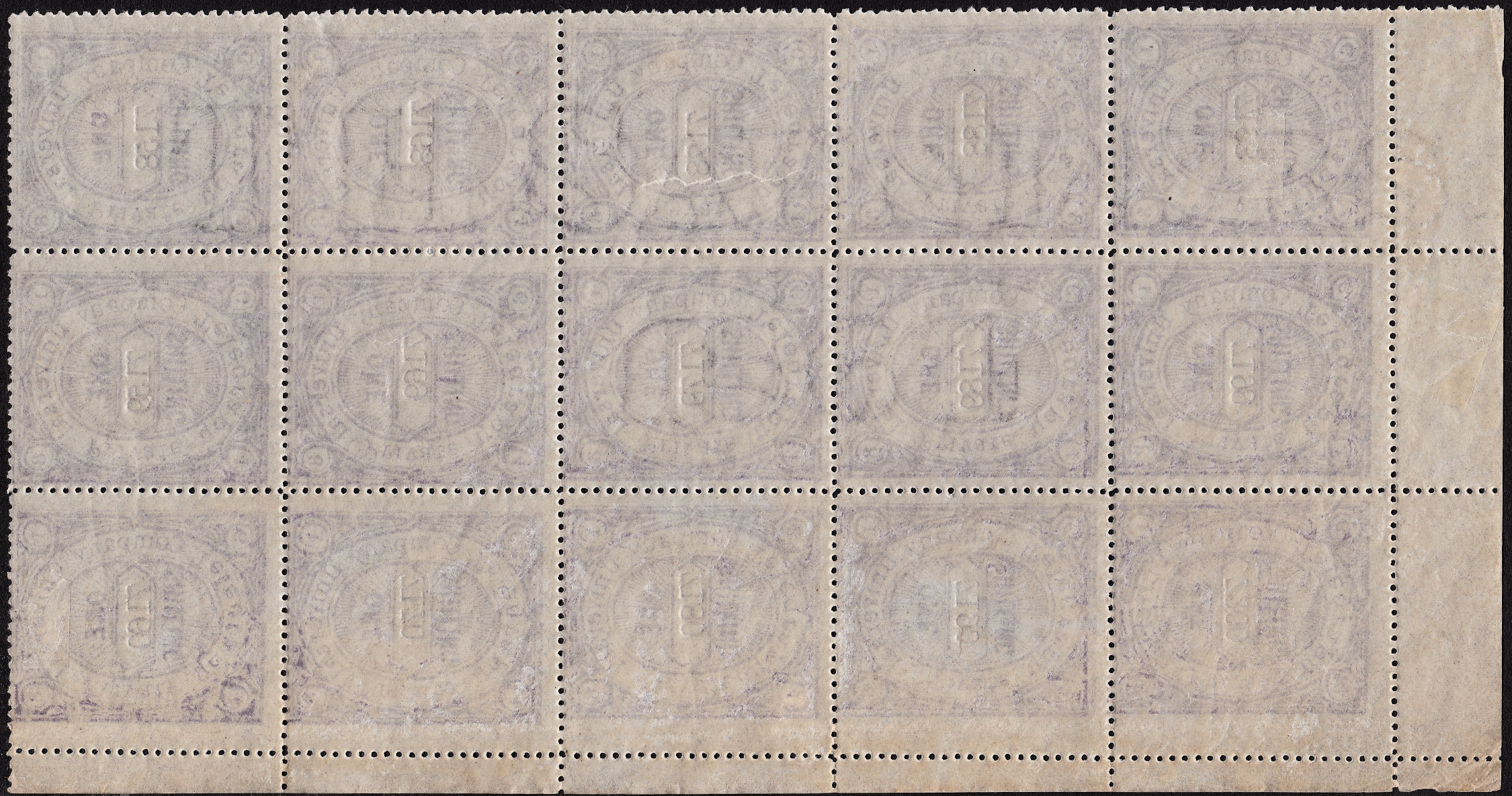 |
|||||
| <— top 7158 (Brown) | 7168 (Brown) | 7178 (Brown) | 7188 (Brown) | 7198 (Brown) bottom —> | |
My attempt to show what the complete watermark looks like.

The 6d is listed as Brown and the 1s as Lilac, though the shades can be variable particularly on the 1s value.
To enable this, I have prepared the following tables and added the information that I already have, including the Mike-Holt.com website and Mark Bloxham ebay store.
I have also found some at WorldClassStamps.co.uk
Keep in mind that a number ending with '00' belongs with the previous 2-digit code. i.e '6800' is the last stamp of the sheet numbered 6701 to 6799, 6800.
| 6d | Second digit | ||||||||||
|---|---|---|---|---|---|---|---|---|---|---|---|
| 0 | 1 | 2 | 3 | 4 | 5 | 6 | 7 | 8 | 9 | ||
| - | yel-green, black, Lilac | yel-green, Lilac | black | yellow-green | yellow-green | ||||||
| 1 | yel-green, Lilac | blue | Lilac | Lilac, blue-green, yellow-green | Lilac, blue | blue-green | blue-green | Lilac | |||
| 2 | blue-green | blue-green | black | black | black, blue-green | blue-green | yellow-green, black | black | blue-green, black | ||
| 3 | black, blue-green | blue-green | black, blue-green | yellow-green | blue-green | blue-green | blue-green | ||||
| 4 | blue-green | blue | blue | blue-green, Lilac | blue | blue | blue | blue | |||
| 5 | blue | blue | blue | blue | blue | blue-green | blue | blue, black | |||
| 6 | blue | blue | blue-green | blue | blue-green, blue | ||||||
| 7 | blue-green | blue-green | blue, blue-green | blue-green, blue | blue-green, blue | blue | blue-green, blue | blue-green | |||
| 8 | blue-green | blue-green | blue-green | ||||||||
| 9 | blue-green | blue-green | blue-green | blue-green | blue | blue-green, black | blue-green | blue-green | black | ||
| 1s | Second digit | ||||||||||
|---|---|---|---|---|---|---|---|---|---|---|---|
| 0 | 1 | 2 | 3 | 4 | 5 | 6 | 7 | 8 | 9 | ||
| - | lilac, brown, yellow | dark-blue, brown | brown | brown | brown | brown, lilac | yellow | yellow | yellow | ||
| 1 | yellow | yellow, red, black | black, brown, yellow | black | brown, yellow | lilac | red, brown | red | brown | ||
| 2 | brown | brown | red | brown | lilac | red | yellow, red | lilac, red, brown | |||
| 3 | lilac, yellow | lilac | lilac, red | yellow | lilac, red | lilac, red | yellow | red, yellow | |||
| 4 | yellow, red | red, green | yellow, red, lilac | red, green, yellow, lilac | red | red | red | green, brown | green, red, black | ||
| 5 | green, red | green, black, red | green, black, brown | green, black, red | green | green, brown | black, red | black | black, red | ||
| 6 | red, black | red, black | red, lilac, black | black | black, brown | black | black, lilac | yellow, lilac | yellow | yellow, green | |
| 7 | brown, yellow | yellow | green, yellow, brown | brown | green, yellow, lilac | green, black | black | green, yellow | green, lilac | yellow | |
| 8 | green | black, yellow | green | green, yellow | black, green | yellow | yellow | red, black, yellow | red, green | red, yellow, green | |
| 9 | green | yellow, green, red | yellow, green | green, red | yellow | red | green | yellow, green | yellow, green, brown | yellow, green | |
Notice that for the 6d with first 2 digits '-1' we have yellow-green and Lilac. this is for '141' and '154' shown above.
I have highlighted the sheet numbers with more than one colour. Clearly these are not from the same physical sheet.
Langmead & Huggins list an estimate of the number of sheets of stamps represented by the samples they had seen.
This is broken down by the colour of the control numbers, and can be used to guage the relative scarcity of them.
I have added for comparison the data from our tables above.
| According to Langmead & Huggins | In our tables above (so far) | ||||||||||||||||||||||||||||||||||||||||||||||||||||||||||||||||||||||||||||||||||||||||||||||||||||
|
|
||||||||||||||||||||||||||||||||||||||||||||||||||||||||||||||||||||||||||||||||||||||||||||||||||||
These quantities may not be proportional to those used. These are remainders,
large quantities of remainders for a particular colour may indicate low usage.
Why different colours of controls for the 6d and 1s values?
Why different numbers of control colours. It may be that there were other colours and some are very rare or no longer extant.
Our tables (so far) represent a few more sheets than estimated by Langmead and Huggins.
I have highlighted where we significantly exceed the L & H estimates. I have also highlighted where they saw significantly more than us.
To me, the fact that we have already seen samples of as many sheets as L&H with 2 rather large anomalies, suggests we both saw a small (and different) subset of the material.
I notice that on the 6d, our totals for yellow-green and blue-green are fairly similar, though individually they account for the biggest discrepancy.
The origin of these is controversial. Some of the commonest known now, were unheard of in earlier years.
| Six Pence | Known by Author | ||||||||||
|---|---|---|---|---|---|---|---|---|---|---|---|
| Control colour | Number of sheets known | Philbrick & Westoby 1881 | Stanley Gibbons 1897 | Stanley Gibbons 1899 | Walter Morley 1900 | Stanley Gibbons 1920 | Stanley Gibbons 1935 | Raymond Lister 1961 | S.E.R.Hiscocks 1982 | J. Barefoot 2013 | Me, ongoing |
| Blue-green | 36 | - | - | "Green" 1s9½d | "Green" NP | "Green" 6d * | "Green" 6d * | NP | £4 | £7.50 | £3.50 |
| Blue | 25 | NP | NP | - | 1s | 1s | 1s | NP | £3 | £7.50 | £4.00 |
| Black | 13 | - | - | - | - | - | - | - | £3 | £7.50 | £5.00 |
| Lilac | 8 | - | - | 1s9½d | NP | 6d * | 6d * | NP | £4 | £7.50 | £6.00 |
| Yellow-green | 8 | - | - | - | - | - | - | NP | £3.50 | £7.50 | £6.00 |
| One Shilling | Known by Author | ||||||||||
| Control colour | Number of sheets known | Philbrick & Westoby 1881 | Stanley Gibbons 1897 | Stanley Gibbons 1899 | Walter Morley 1900 | Stanley Gibbons 1920 | Stanley Gibbons 1935 | Raymond Lister 1961 | S.E.R.Hiscocks 1982 | J. Barefoot 2013 | Me, ongoing |
| Yellow | 37 | - | - | - | NP | 6d * | 6d * | "Orange" NP | £4 | £10 | £3.50 |
| Red | 33 | - | - | 1s9½d | NP | 6d * | 6d * | NP | £4 | £10 | £3.80 |
| Green | 30 | - | - | 1s9½d | NP | 6d * | 6d * | NP | £3.50 | £10 | £4.00 |
| Black | 22 | "Blue" NP | 35s | 1s9½d | 1s | 1s | 1s | NP | £3 | £10 | £4.20 |
| Brown | 22 | - | - | 1s9½d | NP | 6d * | 6d * | NP | £4 | £10 | £4.20 |
| Lilac | 17 | - | - | 1s9½d | NP | 6d * | 6d * | NP | £4 | £10 | £4.80 |
| Dark-blue | 1 | - | - | - | - | - | - | - | - | - | - |
| Notes | Totals 6d-90; 1s-162 |
Only Blue | Set of 7 for 12s6d | World Catalogue | * listed as 'proofs or colour trials' | * listed as 'proofs or colour trials' | Also lists 1s in Chocolate | World Catalogue | World Catalogue | World Catalogue | |
NOTES.
NP = known but Not Priced.
The 6d with black control seems to have been discovered between 1961 and 1982 when suddenly it was common!
Only one shade of 'Green' is listed before Lister, who also distinguishes between 'Brown' and 'Chocolate' and calls 'Yellow', 'Orange'.
It is likely that both shades were known all along, but the difference was not considered worth mentioning.
Just for fun, I thought I would compare the digits of the 6d blue control (5866 and black control 2593 since they are similarly aligned.
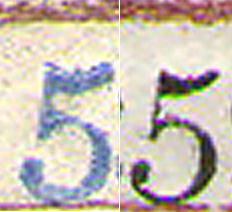
The black controls (or at least mine) seem to be crisper than the other colours which probably accounts for them looking slightly smaller.
The style appears to be the same. I suspect that different colours emerged at different times because they were 'stashed' probably as sheets in different locations.
This might be an indication that the different colours were intended for use at different locations.
Reduced size complete sheet of 1/- stamps, 9501-9600 red.
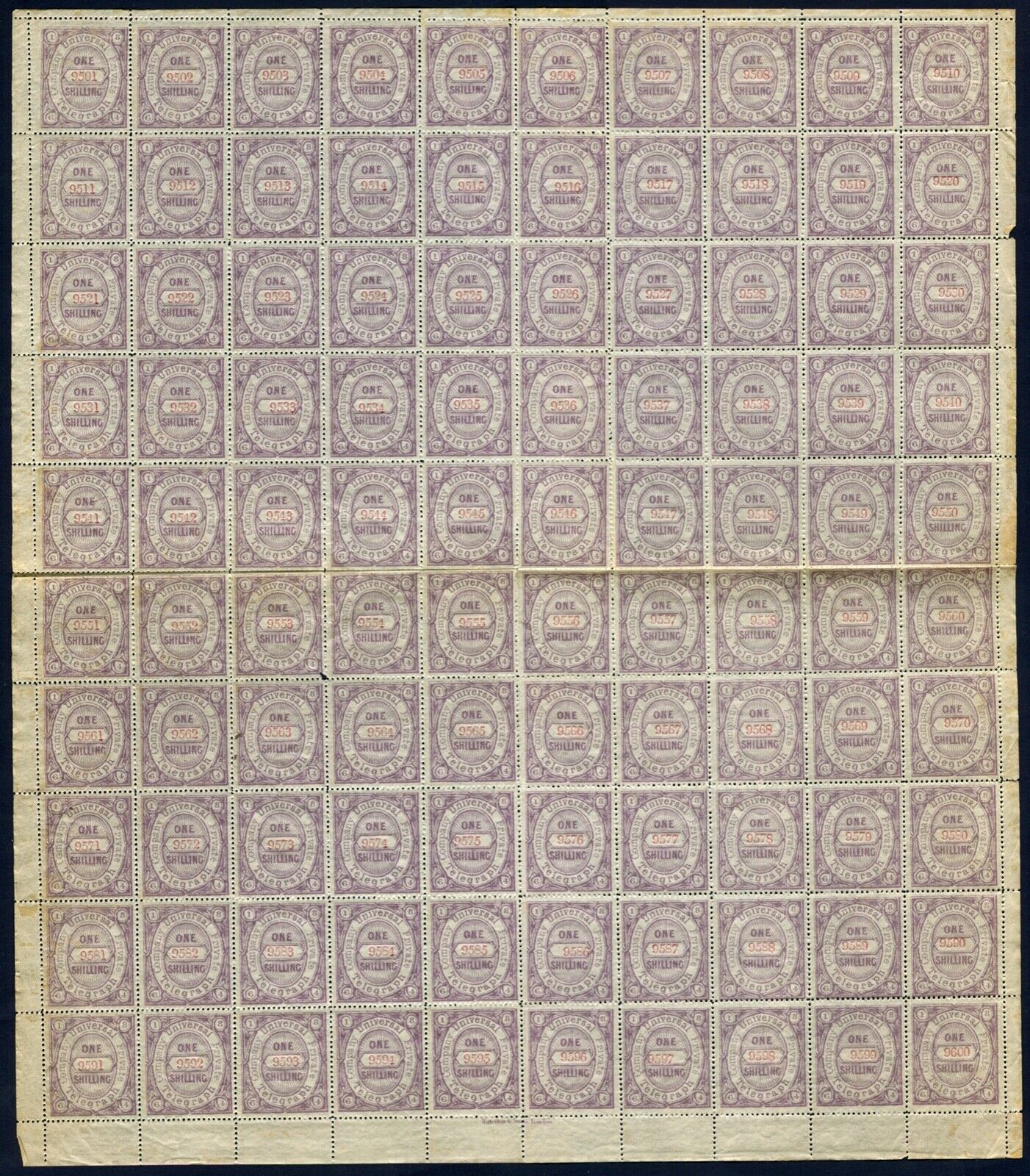
Majed Najjar has kindly made available an image of a complete sheet of the 1/- stamps.
This is a thumbnail of it, a 240 dpi image (10.7MB) can be opened in another tab by clicking here,
or click the image above to see the eBay lot.
A piece from the back of an 1853 envelope.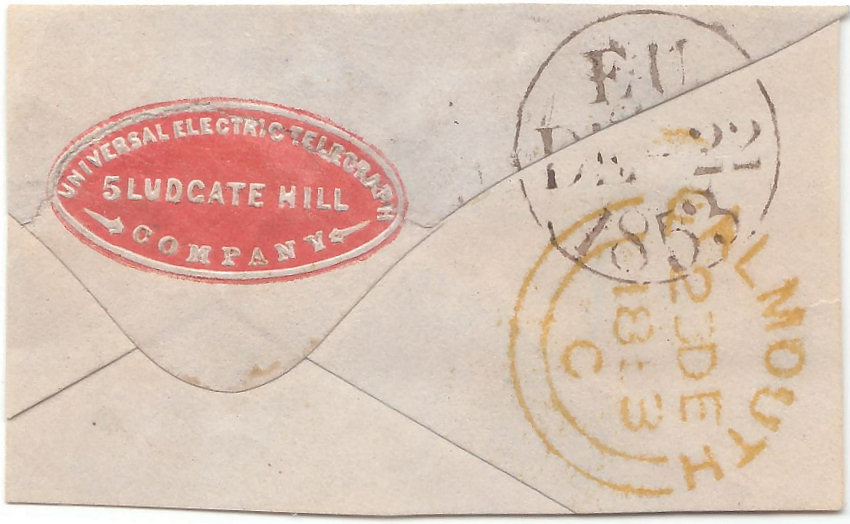
This has a "seal" of the Universal Electric Telegraph Company, 5 Ludgate Hill. on a piece sent to Falmouth on 22 December 1853.
My internet search finds nothing with this precise name, but the closest is the "Universal Telegraph" which may have been an earlier version of the
Universal Private Telegraph Company which specialised in providing private systems. Further information would be welcome.
Though not marked as such on the known examples, it should be noted that (according to Steven Roberts), William Mackenzie, a
"letterpress printer, stereotype founder, engraver, lithographer, bookseller and publisher" of 45 & 47 Howard Street, Glasgow, an early customer of the UPT,
printed the Universal company's initial prospectus, and went on to produce the firm's stationery and instrument manuals for most of its existence.
25 November 1868 receipt for 2/- courtesy of Jim Hammond. - My Ref. UPT-Rec-1868-1
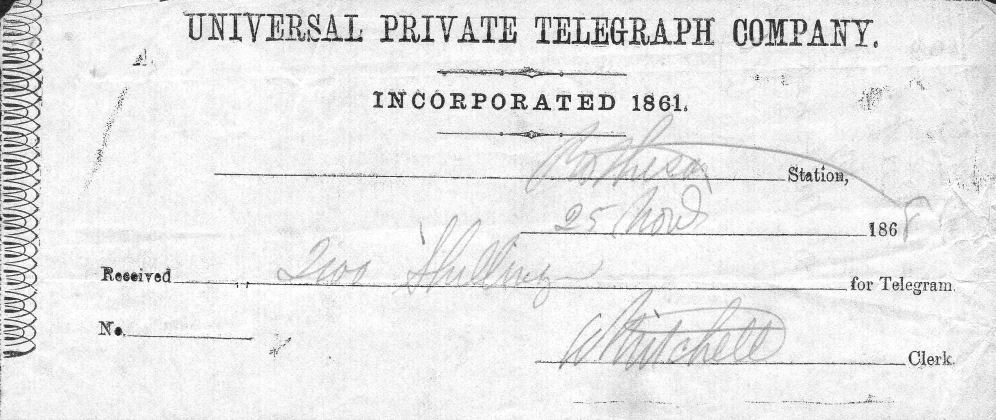
Can anyone read the name of the station ?
29 July1869 Envelope (Charing Cross, London to Glasgow, half scale) - courtesy of Steve Lawrie.
This probably did not contain a telegram. Why would they post from London to Glasgow if they were at a telegraph office ?
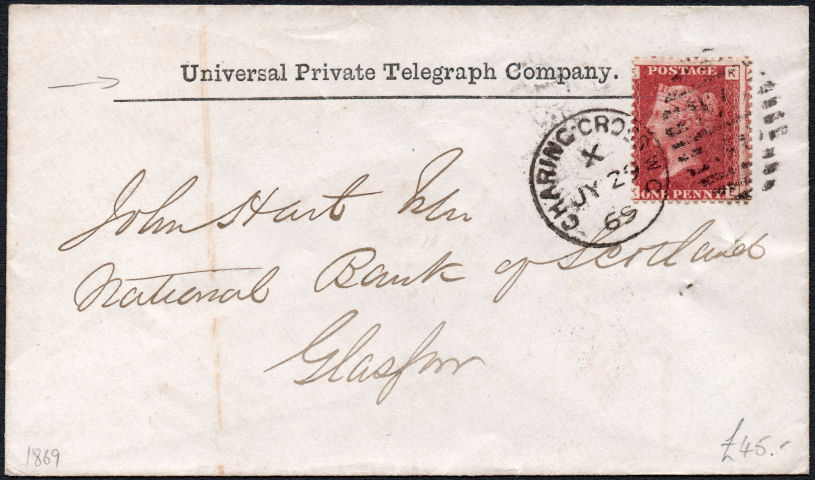
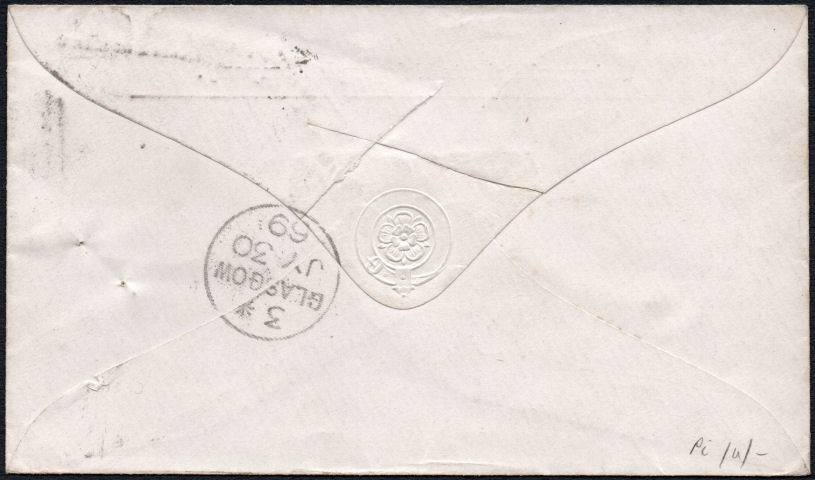
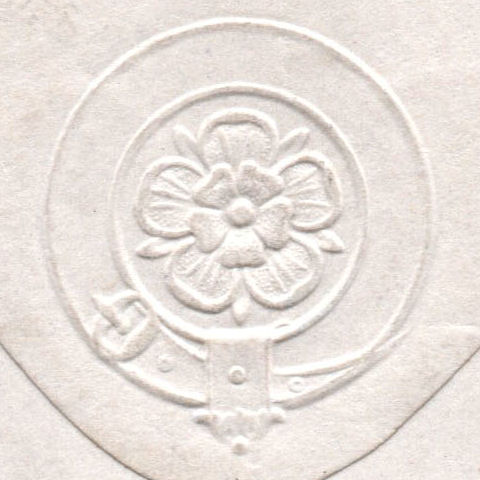
The embossed flap is probably not significant but may help to identify the supplier.
Last updated 6th. December 2023
©Copyright Steve Panting 2012/13/14/15/16/17/18/19/20/21/22/23 except where stated.
Permission is hereby granted to copy material for which the copyright is owned by myself, on condition that any data is not altered and this website is given credit.